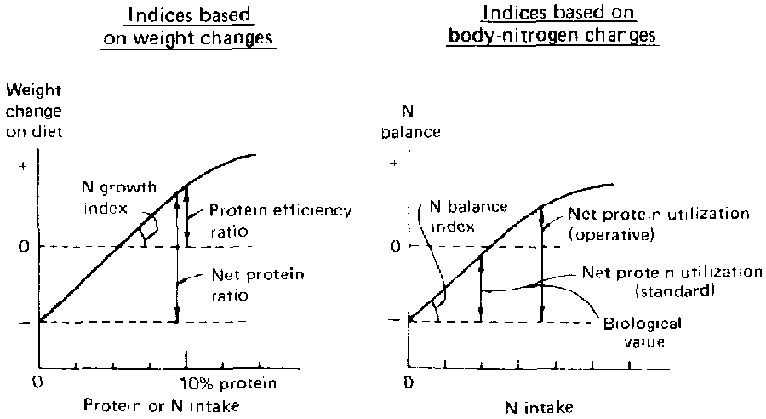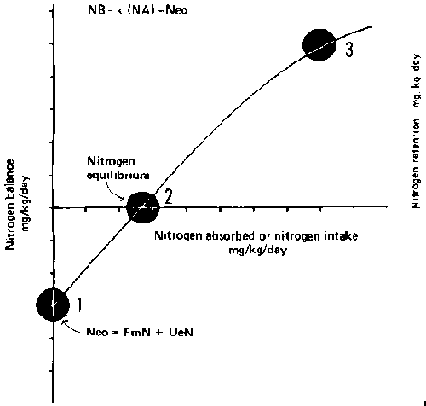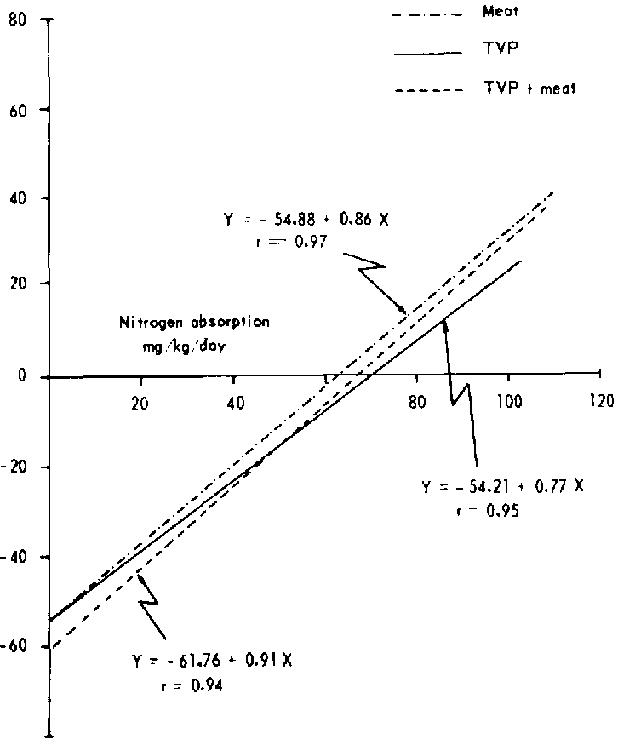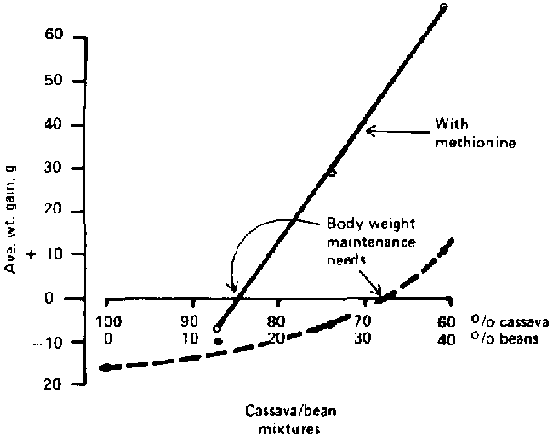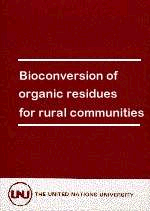
Nutritional evaluation in humans[edit | edit source]
Ricardo Bressani
Institute of Nutrition of Central America and Panama (INCAP), Guatemala City, Guatemala
Introduction[edit | edit source]
It is difficult to realize that, of the total amount of energy devoted to agricultural production, only a small fraction is harvested to be used directly or indirectly for animal and human feeding. Most of the energy is left behind, either in the field, in food processing factories, or feed lots. This unused energy has various forms, and is often of complex chemical composition. It may be biologically inert or highly active; it may be tough or very fragile, and susceptible to rapid deterioration. Most of the time these agricultural residues are a nuisance from the human point of view, for indeed, we call them wastes. There are many examples, but one that illustrates how wasteful agricultural systems can be is the growing of coffee. From 100 9 of dried fruit, only 12 g are actually consumed as solids to make about six cups of coffee (1). For most basic food crops, such as grains and food legumes, the harvest index is only about 0.50.
For various reasons, man is now learning to utilize such wastes, imitating the ways of nature to maintain ongoing biological cycles for the continuation of life in harmonious balance.
The term "waste" describes in a broad, non-specific way the raw material to be utilized, and it is because of its complexity, toughness, and general state that its use in bioconversion systems cannot at present, with a few exceptions, yield products that can be readily utilized directly by man. Therefore, it is difficult to talk about biological evaluation of the products of bioconversion for human use in the context of the raw material itself. It must first be processed. The only known exceptions are algae and mushrooms. This paper presents a discussion of methods used for the evaluation of unconventional products.
Evaluation of products of bioconversion for human consumption[edit | edit source]
The evaluation of bioconversion products to be used for food must take into account four main problems. These are (i) toxicology, (ii) public health aspects, (iii) food technology, and (iv) nutritional quality. The first two are discussed elsewhere in this volume, while the third, consisting mainly of functionality and organoleptic properties, will be only briefly mentioned here. The main emphasis will be given to the fourth consideration - the nutritive value of potential products in terms of their physiological effects and protein quality.
With respect to nutritional evaluation of novel or nonconventional protein sources for human consumption, the Protein Advisory Group (PAG) documents (2 - 6) outline the methods of procedure, including standards for chemical, bacteriological, and toxicological quality, as well as procedures for feeding tests, including acceptability, tolerance, and protein quality evaluation. Therefore, if bioconversion products produced for human feeding meet these standards, they can be considered acceptable for use as components of food. Four products potentially useful as food sources are products derived from animals fed bioconversion products, conventional fermented foods as used in the Far East, algae, and other single-cell proteins. Before discussing them individually, present methods of protein quality evaluation will be briefly described.
Procedures for nutritional evaluation in humans[edit | edit source]
Once non-traditional food sources began to be utilized for human consumption, guidelines for their safety had to be established. The PAG documents already mentioned (2, 3) include complete evaluation of novel protein sources in at least two animal species before any clinical trials, using the procedures described in Figure 1.
Figure. 1. Procedures for Measuring the Nutritive Values of Proteins
The protein evaluation tests summarized in the figure fall into two categories: Those based on weight gain of the animals, and those based on carcass protein deposition. Most of the methods are one-point assays; however, multiple points are preferred, particularly in view of the linear relationship, which permits a fairer evaluation of the protein under study. For those methods based on weight changes, protein intake is also calculated to determine protein efficiency ratio (PER), net protein ratio (NPR), and others. Carcass nitrogen deposition can be measured either directly in experimental animals, or by the nitrogen balance method, which is applicable to both animals and man. Nitrogen balance is defined as the difference between nitrogen intake and total output in faeces and urine. The methods based on these measurements are net protein utilization (NPU), biological value (BV), and nitrogen balance index (NBI). The former two represent one-point assays; the latter is a multiple-point assay.
The protein quality evaluation method used in our laboratories with children and young adult human subjects is the multiple-point intake technique (NBI), where the material under study is the only source of protein and the only variable, with intake of other essential nutrients, such as calories, vitamins, and minerals kept constant and at adequate levels (Figure 2). Basically, it consists of feeding the protein source, with other non-protein foods providing flavour and texture, at three or four levels of intake, one level below the nitrogen equilibrium line, one or two close to it, and one above. The purpose of such a feeding system is to obtain the relationship between nitrogen or protein intake, or the amount absorbed, and nitrogen balance. This last term - nitrogen balance - is equal to the difference between intake and total excretion of nitrogen as measured in faeces and urine. Regression analysis of the results obtained provides an index of biological value, represented by the coefficient of regression, or the slope of the line when it is calculated from the nitrogen absorbed and nitrogen retained values. The magnitude of the slope is an index of the efficiency of protein utilization. Values approaching one show the highest efficiency. When the regression is calculated between nitrogen intake and nitrogen balance, the coefficient is equal to net protein utilization, and again shows the efficiency of utilization. An example for three protein sources is shown in Figure 3, where the different regression coefficients indicate different protein quality values.
Figure. 2. The Basic Principle of the Nitrogen Balance Index
Figure. 3. Nitrogen Balance Index of Texturized Vegetable Protein, Meat, and 50:50 Combination (short method)
This method of evaluating protein quality provides additional data. Furthermore, the point of interception at the equilibrium line indicates the amount of protein required for maintenance purposes. The application of this technique varies to some extent when used in children. The main difference is that diets without nitrogen are not fed to children in contrast to diets fed to adults, for whom this step is necessary in order to promote adaptation to low-protein intakes. Furthermore, protein levels of intake fed to children are higher than those for adults, because children have higher protein requirements to allow for growth.
The duration of this experimental method is usually long because it is a multiple-point assay, and because there is usually an adaptation period before collection of biological material for analysis. The usual time is about 36 days. We recently proposed a modification of this method that reduces the time to nine days for young adults (7), and studies are currently under way to apply it to children. Some data on values obtained by our modified short-term method compared to those from the conventional assay are shown in Table 1. These data strongly suggest that the experimental time may be decreased without major differences in protein quality evaluation results (8).
The evaluation of various food products[edit | edit source]
Food Products Derived from Animals
Domestic animals such as ruminants, swine, and poultry will probably be fed more and more products containing materials from bioconversion processes. It is not expected, however, that this practice will change the quality of the protein derived from the animals. Changes in the chemical composition of animal tissues may occur, as well as deposition in the tissues of heavy metals, insecticide and herbicide residues, and other additives. If the levels of these substances become too high, the animals will show a decrease in overall performance, which, in turn, should lead to elimination of the product from the feed. If the animals gain weight and show good feed-conversion efficiency and overall performance, it is a good indicator that food products made from such animals will be of high enough quality to be used for human feeding. This, however, does not imply that quality control evaluation should not be carried out on food products obtained from animals fed bioconversion products or biomass (6).
TABLE 1. Protein Intake for Nitrogen Equilibrium Using the Conventional and Short-Term NBI (g/kg) in Adult Human Subjects
| Protein source | Conventional | Short-term |
| Soy isolate | 0.67 | 0.54 |
| Milk | 0.63 | 0.62 |
| 50/50 beef/soy | 0.59 | 0 57 |
| Beef | 0.64 | 0.53 |
Source: Bressani et al. (8).
Conventional Fermented Foods
Fermented foods have been consumed for a long time by populations living in various parts of the world. Although there are several kinds, only three will be discussed in terms of protein quality. These are: (a) foods such as tempeh, a fermented food based on soybeans, a high-oil, high-protein seed; (b) fermented foods based on cereal grains, mainly rice, and (c) fermented foods based on starchy foods such as cassava.
The impact of the fermentation process on the protein quality of the end-product will be considered first. To predict its protein quality, it is essential to know the value of the starting material and the value of the biomass itself. In the case of tempeh, soybean protein is deficient in sulphur amino acids and rich in lysine. The biomass produced on it also contains protein deficient in sulphur amino acids and rich in lysine. Therefore, the protein quality of tempeh will be equivalent to the average of the protein content in the soybean and in the fermented biomass, depending on the amount of protein supplied by each source.
There are no data available on the protein quality of biomass produced on cereal grains. Cereal-grain protein, however, is deficient in lysine, while microbial protein is a rich source of this amino acid. Table 2 shows the nutritional impact of small amounts of yeast added to maize, wheat, and rice. In each case, there is a significant increase in protein quality, suggesting that production of biomass on cereal grains for human feeding would be beneficial to the consumer, assuming that the product would be acceptable organoleptically (9 - 11).
TABLE 2. Supplementary Effect of Small Amounts of Torula Yeast Added to Various Cereal Grains
| Cereal grain |
Amount of torula added (%) |
Protein quality PER |
| Maize | 1.23 | |
| 3 | 2.06 | |
| Whole wheat | 1.81 | |
| 4 | 2.17 | |
| Wheat flour | 0.82 | |
| 8 | 2.18 | |
| Rice | 1.87 | |
| 6 | 3.13 |
Sources. Bressani and Marenco (9); Jarquin et al (10); Elias et al. (11).
There have been few nutritional studies on the protein value of biomass grown on starchy foods. Therefore, to predict its possible use, the analogy of supplementing cassava with beans will be used. SCP and legume foods are also deficient in sulphur amino acids and rich in lysine. The results in Figure 4 show that body weight in rats is maintained when cassava is supplemented with 30 per cent of beans, providing 7.5 9 of protein. However, when bean protein is supplemented with methionine, the body-weight gain of rats fed the bean-cassava diet is maintained with only 15 per cent of beans, providing about 4.5 9 of protein. These results imply that, in order to increase protein content in starchy foods by biomass production, the protein content should be higher than 8 per cent to maintain body weight in experimental animals.
Algae
Algae have been used as food for centuries. They form a part of the diet of the people living around Lake Chad in Africa, and were eaten by the Aztecs in Mexico. Among the several thousands of green and blue algae known, the following have been found adequate for large- or small-scale cultivation: the green algae, Chlorella vulgaris, Scenedesanus acutus, Coelastrum proboscideum, and the blue-green algae, Spirulina maxima. The following discussion of algae is based on information from other laboratories, as we have not gone beyond chemical and animal studies with Microcystis sp. (12).
Figure. 4. Nutritional Significance of Bean Protein Quantity and Quality to Cassava-Based Diets
TABLE 3. Some Observations Made on Human Subjects Fed Algae Protein (10 to 500 g/day)
Unacceptable smell
Disagreeable flavour
Poor appearance of food
Gastro-intestinal discomfort
Poor digestibility of nutrients
Nausea at high levels of intake
Urine and blood analyses normal
After additional processing:
More acceptable organoleptically
Gastro-intestinal problems persisted
Not many results have been reported recently on nutritional evaluation trials using algae grown on different types of biomass for human subjects. This is probably not due to a lack of interest in manufacturing such products, but rather to the initial results obtained in 1963 - 68 that showed a variety of adverse effects in subjects fed algae or other SCPs. As shown in Table 3, clinical trials with algae were particularly discouraging (13 - 17). Most materials containing algal protein showed low digestibility for most nutrients, and caused gastrointestinal discomfort. Unacceptable smell, taste, and disagreeable flavour produced nausea. However, it became evident that further processing by alcohol extraction improved the product significantly.
In more recent reports, materials produced and processed by improved technologies have yielded products that offer more promise. Some of these results are shown in Tables 4 and 5, indicating better protein digestibility and biological value, while urine and blood analyses are no different from those observed after feeding casein, a universally acceptable protein. However, it is costly to create acceptable foods from algae. These results suggest that the production of such materials for rural communities would be better directed towards animal feed, where they will be more beneficial to man in the long run.
Concept of productivity[edit | edit source]
Economic considerations in systems of food production, whether they are food crops, livestock, or bioconversion products, take into account only the total amount produced, with little regard to whether the products will be used efficiently. In view of this, we define productivity as total production per hectare, or per unit of weight or volume, corrected by a food technology factor and by a nutritive value factor (18):
TABLE 4. Protein Quality of Chlorella, Yeast, and Casein in Human Subjects
|
Dietary protein |
Nitrogen intake g/day |
Nitrogen balance g/day |
True protein digestibility % |
Protein quality B.V. % |
| Casein + RNA | 4.25 | - 1.00 | 95 | 66 |
| 7.84 | +0.33 | 99 | 52 | |
| Chlorella | 4.83 | +0.28 | 89 | 79 |
| 7.81 | +0.05 | 82 | 60 | |
| Torula | 4.51 | - 1.23 | 83 | 70 |
| 8.20 | +0.39 | 87 | 58 |
Source: Waslien et al. (17).
Productivity = Production/ha x Food technology factor x Nutritive value
This equation is applicable to production of foods from soil or other sources, such as those described in these proceedings, and is applicable to evaluation of feed for animals and also food for human consumption.
The term "food technology" in the formula has two components. One is related to those characteristics of a food or product that introduce functionality, texture, and structure to food systems. For example, the high-yielding variety of rice IR8 was not accepted by the consumer because it did not meet the eating quality associated with rice. The second component is related to the capacity of the product to undergo processing without physical, chemical, or microbiological deterioration. An example would be milled Opaque-2 corn, which has a low yield of grits because of the nature of the endosperm. In the area of biomass, specifically algae, the green colour is an example of the first food technology component, and bacteria-induced deterioration is an example of the second.
The nutritive value factor in the equation is related to the efficiency with which the nutrients of the food products, whether they are calories, proteins, or any other specific nutrients, are utilized.
One example that shows the effect of better land use through a more efficient utilization of the protein in cereal grains is presented in Table 6. For children, the amount of protein from corn needed for equilibrium, that is, neither weight gain nor loss, requires cultivation of 69 and 182 kg/yr of Opaque-2 and common maize, respectively. These amounts of protein are lost in faeces and urine because the figures represent the condition at protein equilibrium, and are equivalent to 0.013 and 0.035 ha per person per year. For adults, the results show the same trend; i.e., less land use due to more efficient utilization of the nutrients in Opaque-2 maize than those in common corn. Therefore, productivity expressed in production per unit area should also include the efficiency of utilization of the crop produced. Even with the 10 - 15 per cent lower yield and a slightly lower food technology factor, Opaque-2 maize has a higher productivity than can be derived from common corn.
TABLE 5. Urinary and Plasma Uric Acid Levels of Men Fed Nucleic Acid Added to Casein and as Found in Algae and Yeast
| Diet |
Nucleic acid intake (g/day) |
Uric acid (mg) Urine/day |
Plasma/100 ml |
| Protein-free | 394 | 5 4 | |
| Casein + RNA | |||
| 25 g prot | 1.8 | 562 | 6.9 |
| 50 g prot | 3.7 | 886 | 8.7 |
| Chlorella | |||
| 25 g prot | 1.7 | 605 | 7.4 |
| 50 g prot | 3.6 | 872 | 9.7 |
| Torula | |||
| 25 g prot | 5.0 | 942 | 10.2 |
| 50 g prot | 10.3 | 1,536 | 12.6 |
Source: Waslien et al. (17).
Table 7 shows the significance for productivity of low and high digestibility bean protein. Using the results from nitrogen balance studies, it can be seen that low digestibility results in poor land use because significant amounts of N are lost in the faeces in comparison to N loss when a material of higher digestibility is fed.
TABLE 6. Amount of Corn Protein Found Experimentally to Be Necessary for Nitrogen Equilibrium in Children and Adult Subjects
|
Type of corn Opaque-2 |
Common | |
| Children | ||
| g protein/child/day | 16.8 | 45.0 |
| g corn/child/day | 188 | 500 |
| kg corn/child/year | 69 | 182 |
| ha/person/year | 0.013 | 0.035 |
| Adults | ||
| g protein/head/day | 27.9 | 43.8 |
| g corn/head/day | 250 | 547 |
| kg corn/head/year | 91 | 200 |
| ha/person/year | 0.018 | 0.040 |
The above is based on a yield of 5,000 kg/ha.
TABLE 7. Efficiency of Land Utilization in Terms of the Protein from Beans (Phaseolus vulgaris)
|
Protein of 64% digestibility |
Protein of 84% digestibility | |
| Yield of beans/ha, kg | 1,000 | 1,000 |
| Yield of protein/ha, kg | 230 | 230 |
| Protein absorbed/ha, kg | 147 | 193 |
| Protein waste/ha, kg | 83 | 37 |
| Waste as beans/ha, kg | 360 | 160 |
| % land poorly utilized | 36 | 16 |
| Nitrogen intake | 227 | 227 |
| Faecal nitrogen | 81 | 36 |
| Urinary nitrogen | 109 | 109 |
| Nitrogen absorbed | 146 | 191 |
| Nitrogen retained | 37 | 82 |
Finally, energy inputs into agricultural production systems are also affected by the quality of the end-product. Table 8 shows calculation of agricultural and nutritional efficiency using data from Pimentel et al. (19).
With respect to nitrogen input, agricultural efficiency for corn is 0.61 whether it is common or Opaque-2 maize. However, the nutritional efficiency of the nitrogen input is 0.44 for Opaque-2 maize and a significantly lower value of 0.19 for common corn. For energy inputs, the returns of agricultural efficiency for both types of corn would be 2.82; on the other hand, the nutritional efficiency of the energy input would be 1.35 for Opaque2 corn and a very low value of 0.87 for common corn.
TABLE 8. Agricultural Productivity of Cereal Grains of Improved Nutritional Value Out put/input
| Parameter |
Output/input Common corn |
Opaque-2 corn |
| For N inputs in corn production | ||
| Agricultural efficiency (grain) | 0.61* | 0.61* |
| Nutritional efficiency | 0.19 | 0.44 |
| For energy input in corn production | ||
| Agricultural efficiency (grain) | 2.82. | 2.82* |
| Nutritional efficiency | 0.87 | 1.35 |
* Equal yields/ha were assumed.
These calculations indicate that, independent of the nutrition problem, there are practical advantages in producing food grains of the highest possible protein quality.
Conclusions[edit | edit source]
As I indicated in the introduction to this paper, the harvest indices from food crops are small, and the amounts of potential energy left in the field are very large. Even smaller indices are obtained after food is processed, indicating still greater wastes. As the papers in this proceedings show, there are various products that can be made by bioconversion. In my opinion, especially in rural areas, priority should be given to processes that will convert wastes into materials that will induce better structure and fertility in soils and hence make them more productive. Second, biogas production also has potential and is a system that is compatible with bioconversion processes. A third approach would be to produce biomass that, without any further processing, can be used as animal feed. Some wastes can be converted into foods for man, but because of the types of raw material used and the subsequent processing needed to make such products wholesome for human consumption, large-scale industries are required. Quality products can thus be made to enter the present food consumptions systems.
References[edit | edit source]
- J.E. Braham and R. Bressani, (eds.), Pulpa de Cafe. Composici�n, Technologia y Utilizaci�n. IDRC 108 s.
- Protein-Calorie Advisory Group of the United Nations System (PAG) Guideline No. 6, "Preclinical Testing of Novel Sources of Protein," United Nations, New York.
- PAG Guideline No. 7, "Human Testing of Supplementary Food Mixtures," revised, in PAG Bulletin 3 (No. 3): 12 19 119731.
- PAG Guideline No. 8, "Protein-Rich Mixtures for Use as Weaning Foods," United Nations, New York, 1971.
- PAG Guideline No. 12, "Production of Single-Cell Protein for Human Consumption," United Nations, New York, 1972.
- PAG Guideline No. 15, "Nutritional and Safety Aspects of Novel Protein Sources for Animal Feeding," United Nations, New York.
- D.A. Navarrete, V.A. Louiro de Daqui, L.G. El�as, P.A. Lachance, and R. Bressani, "The Nutritive Value of Egg Protein as Determined by the Nitrogen Balance Index (NBI), Nutr. Rep. Internat. 16:695 704 (1977).
- R. Bressani, D.A. Navarrete, L.G. Elias, and J.E. graham, "A Critical Summary of a Short-Term Nitrogen Balance Index to Measure Protein Quality in Adult Human Subjects," in H.L. Wilcke, D.T. Hopkins, and D.H. Waggle (eds.), Proceedings of a Conference on Soy Protein and Human Nutrition, Keystone, Colorado, 22 25 May 1978. Academic Press, New York. (proceedings in press.)
- R. Bressani and E. Marenco, "The Enrichment of Lime-Treated Corn Flour with Proteins, Lysine and Tryptophan, and Vitamins," J. Agric. Food Chem. 11: 517 - 522 (1963).
10. R. Jarquin, P. Noriega, and R. Bressani, "Enriquecimiento de Harinas de Trigo, Blanca e Integral, con Suplementos de Origen Animal y Vegetal," Arch. Latineamer, Nutr. 16: 89 - 103 (1966).
11. L.G. Elias, R. Jarquin, R. Bressani, and C. Albertazzi, Suplementaci�n del Arrox con Concentados Proteinicos," Arch. Latinoamer. Nutr. 18: 27 - 38 (1968).
12. G.A. De la Fuente, M. Flores, R. Molina, L. Almengor, and R. Bressani, "Some Nutritional Characteristics of a Naturally Occurring Alga (Microcystis sp.) in a Guatemalan Lake," Appl. Environ. Microbiol. 33: 6 - 9 (1977).
13. Y. Morimura and B. Tamiya, "Preliminary Experiments in the Use of Chlorella as Human Food," Food Technol. 8: 179 - 182 (1954).
14. R.C. Powell, E.M. Nevels, and M.E. McDowell, "Algae Feeding in Humans," J. Nutr. 75: 7 - 12 (1961).
15. R. Dam, S. Lee, P.C. Fry, and H. Fox, "Utilization of Algae as a Protein for Humans," J. Nutr 86: 376 - 382 (19651.
16. S.K. Lee, H.M. Fox, C. Kies, and R. Dam, "The Supplementary Value of Algae Protein in Human Diets," J. Nutr. 92: 281 - 285 (1967).
17. C.I. Waslien, D.H. Calloway, S. Margen, and F. Costa, "Uric Acid Levels in Men Fed Algae and Yeast as Protein Sources," J. Food Sci. 35: 294 - 298 (1970).
18. R. Bressani, "Productivity and Improved Nutritional Value in Basic Food Crops," in Improving the Nutrient Quality of Cereals. II. Report of Second Workshop on Breeding and Fortification, September 1976, p. 265, AID Washington, D.C.
19. D. Pimentel, L.E. Hurd, A.C. Belloti, M.J. Forster, I.N. Oka, O.D. Sholes, and R.J. Whitman, "Food Production and the Energy Crisis," Science 182: 443 - 449 (1973).
Discussion summary: Papers by van Weerden, Shacklady, and Bressani[edit | edit source]
Asked about the meaning of the term "technological quality" of proteins, Dr. 8ressani replied that the phrase was used to indicate how amenable (or otherwise) protein preparations are to normal domestic or industrial processing. It was recommended that new preparations should be evaluated in terms of their replacement for other protein sources rather than in absolute terms. This is, in fact, the normal procedure when evaluating food mixtures for human consumption.
Senez, commenting upon van Weerden's paper, pointed out that the rations containing yeast in the experiments he described were generally supplemented with methionine. With regard to the apparent differences in species response to the fungus tested, he wished to stress that it related to only one out of several thousands of fungi that might be used. van Weerden agreed with both comments, but said that the latter served to underline his contention that we know very little about this very large subject.
Stanton commented upon the one in one million level of risk mentioned by Shacklady and said this was close to the natural frequency of mutation of many bacteria. He also suggested that Tetrahymena pyriformis could be a useful organism for field-workers comparing or evaluating potential feed ingredients. In reply, Shacklady said that the one in one million possibility of error referred, not to mutagenicity studies, but to lifespan feeding studies on experimental animals, and simply indicated the magnitude of the studies acceptable to the FDA Regarding T. pyriformis, this has been used by some workers as an index of protein quality, but it has a number of disadvantages, one being that it does not have an absolute requirement for lysine, frequently the first limiting amino acid in cereals. As far as Shacklady knows, it has not been used in mutagenicity studies, the most commonly used organisms being Salmonella typhimurium mutants along with those of Escherichia cold and Bacillus subtilis.
